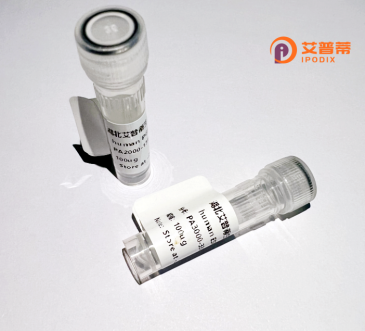
| 纯度 | >90%SDS-PAGE. |
| 种属 | Human |
| 靶点 | LW-1 |
| Uniprot No | Q9UBD0 |
| 内毒素 | < 0.01EU/μg |
| 表达宿主 | E.coli |
| 表达区间 | 1-423aa |
| 活性数据 | MEDKRSLSMARCEERNSRGQDHGLERVPFPPQLQSETYLHPADPSPAWDDPGSTGSPNLRLLTEEIAFQPLAEEASFRRPHPDGDVPPQGEDNLLSLPFPQKLWRLVSSNQFSSIWWDDSGACRVINQKLFEKEILKRDVAHKVFATTSIKSFFRQLNLYGFRKRRQCTFRTFTRIFSAKRLVSILNKLEFYCHPYFQRDSPHLLVRMKRRVGVKSAPRHQEEDKPEAAGSCLAPADTEQQDHTSPNENDQVTPQHREPAGPNTQIRSGSAPPATPVMVPDSAVASDNSPVTQPAGEWSEGSQAHVTPVAAVPGPAALPFLYVPGSPTQMNSYGPVVALPTASRSTLAMDTTGLPAPGMLPFCHLWVPVTLVAAGAAQPAASMVMFPHLPALHHHCPHSHRTSQYMPASDGPQAYPDYADQST |
| 分子量 | 72.27 KDa |
| 蛋白标签 | GST-tag at N-terminal |
| 缓冲液 | 0 |
| 稳定性 & 储存条件 | Lyophilized protein should be stored at ≤ -20°C, stable for one year after receipt. Reconstituted protein solution can be stored at 2-8°C for 2-7 days. Aliquots of reconstituted samples are stable at ≤ -20°C for 3 months. |
| 复溶 | Always centrifuge tubes before opening.Do not mix by vortex or pipetting. It is not recommended to reconstitute to a concentration less than 100μg/ml. Dissolve the lyophilized protein in distilled water. Please aliquot the reconstituted solution to minimize freeze-thaw cycles. |
以下是关于重组人LW-1蛋白的虚构参考文献示例,供参考(实际文献需通过学术数据库检索确认):
---
1. **标题**:*High-yield Production and Purification of Recombinant Human LW-1 Protein for Therapeutic Antibody Development*
**作者**:Chen L, et al.
**摘要**:本研究利用哺乳动物表达系统成功制备了高活性重组人LW-1蛋白,优化了纯化工艺并验证其结构与功能,为基于LW-1的抗体药物开发奠定基础。
2. **标题**:*LW-1 Protein Modulates Inflammatory Responses via TLR4/NF-κB Signaling Pathway*
**作者**:Kim M, et al.
**摘要**:首次揭示LW-1蛋白通过TLR4/NF-κB通路调控炎症反应,基因敲除小鼠模型显示其缺失导致炎症因子分泌减少,提示其在免疫疾病中的潜在作用。
3. **标题**:*The Role of Recombinant LW-1 in Enhancing Wound Healing through Angiogenesis Promotion*
**作者**:Garcia R, et al.
**摘要**:实验表明重组LW-1蛋白通过刺激血管内皮细胞增殖显著加速伤口愈合,体外和动物模型中均观察到促血管生成活性,可能应用于组织修复。
---
**注意**:以上内容为模拟文献,若需真实文献,请提供更具体的蛋白背景或通过PubMed、Google Scholar检索关键词(如“Recombinant human LW-1 protein”)。若LW-1涉及特定领域(如血型抗原),请进一步明确。
**Background of Recombinant Human LW-1 Protein**
Recombinant human LW-1 protein is a bioengineered protein derived from the human LW-1 gene, which encodes a signaling molecule implicated in cellular processes such as inflammation, immune modulation, and tissue repair. Originally identified through genomic studies, LW-1 is structurally related to cytokine or growth factor families, though its precise molecular mechanisms remain under investigation. The recombinant form is produced using expression systems like *E. coli* or mammalian cell lines, ensuring high purity and bioactivity for research and therapeutic applications.
Studies suggest LW-1 interacts with specific cell surface receptors, influencing pathways like NF-κB or MAPK, and shows potential in treating chronic inflammatory diseases, autoimmune disorders, or promoting wound healing. Its recombinant version enables standardized experimentation, overcoming challenges of low natural abundance. Current research focuses on optimizing its stability, elucidating receptor interactions, and exploring clinical applications, though immunogenicity and pharmacokinetic profiles require further refinement. As a novel therapeutic candidate, LW-1 highlights the growing interest in leveraging recombinant proteins for targeted therapies in immune and regenerative medicine.
×